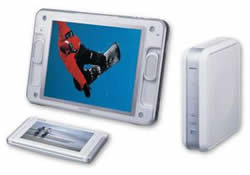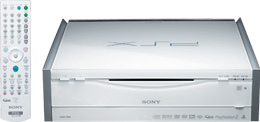The US Federal Communications Commission (FCC) has elected to adopt the ATSC flag, otherwise known as the Broadcast flag – a digital code that can be embedded into a digital broadcasting stream to mark content as protected. All equipment capable of receiving a Digital TV (DTV) signal, be that TV or computer, sold after 1 July, 2005 in the US must comply with the ruling.
Content owners have been lobbying hard to try and get it brought into law, as they felt the broadcasting of their content in a digital format without the flag would lead to widespread piracy. Others, including the Electronic Frontier Foundation (EFF), raised a number of objections to the most stringent of restrictions and were particularly concerned with the protection of consumers current “fair use” rights. It appears that the FCC has listened to all sides of the debate and have accounted for their views.
The FCC announced ruling is that only equipment that is capable of receiving Digital TV (DTV) signals over the air will be affected and must “recognize and give effect to the broadcast flag”. The recording equipment and possible content protections schemes they employ will be addressed at a later date and are described below.
Alternative protection schemes had been proposed to the FCC. The considered the encryption of content at the broadcaster and the use of watermarking or fingerprinting technologies. Both of these were rejected at this stage as it was felt that the technologies were currently not mature enough and, in the case of encryption the burden on the broadcaster would be too great.
The FCC state the main aim of the ruling is to stop the wide distribution of the recorded content over the Internet. Many parties will be pleased that consumers will still be able to make personal digital copies. In the FCC words “redistribution control is a more appropriate form of content protection for digital broadcast television than copy restrictions”.
While the FCC is at pains to point out that that they feel it is important that consumers are able to move recorded content around, what they call, the Personal Digital Network Environment (PDNE), they have declined to define where the edges of this lay.
Although currently there are no detail given about the mechanism to stop personal copies be distributed wider a field, more detail on this are expected later.
One fear of consumers, who have already spent large amounts of money on DTV capable equipment, was that they would be forced to discard their current euipment and buy new, compliant equipment. They will be pleased to discover that this will not be the case; “All existing equipment in use by consumers today will remain fully functional”.
New DTV equipment, “Demodulator Products” sold after 1 July, 2005 in the US must comply with the ruling;
“If the flag is present, the content can be sent in one of several permissible ways, including (1) over an analog output, e.g. to existing analog equipment; or (2) over a digital output associated with an approved content protection or recording technology”
It is not clear if the quality that the digital broadcast brings will remain in the analogue output, or if it will be forcefully degraded to discourage the digital distribution of possible analogue recordings.
Changes to DVD
While it has been stated that current TV equipment will remain useable, the future for current DVD players is far less secure. Hidden in footnote 47 the FCC states:
“We recognize that currently, content recorded onto a DVD with a flag-compliant device will only be able to be viewed on other flag compliant devices and not on legacy DVD players. While we are sensitive to any potential incompatibilities between new and legacy devices, we believe that this single, narrow example presented to us is not unique to a flag system and is outweighed by the overall benefits gained in terms of consumer access to high value content. Changes in DVD technology, such as the transition to high definition DVD devices, will present other unrelated format incompatibilities.”
The briefly translates to DVD players currently on the market will not be able to play DVDs which have been marked with a Broadcast Flag.
Given that DVD is famously the fastest ever growing consumer technology, it is not clear what the public views will be on the fact they will need to replace them.
Affect on the broadcaster
As covered above, the broadcaster will avoid the burden of having to encrypt content prior to broadcast.
The FCC has given individual broadcasters the freedom to make their own decisions as to whether they attach the Flag to their broadcast stream, but points out that they may not have content licensed to them, if they do not implement it.
Some groups urged that the broadcast of certain types of programming, such as news and current affairs, would be prohibited from use of the Flag – in effect during their transmission, they would be forced to turn the Flag off. The FCC has ruled to decline this.
Further discussion on recordings
As we have touched on, while the current ruling only covers the receiving equipment, the FCC is now seeking guidance on creating policy for recording equipment and content protection schemes.
This is the area that will prove most controversial, as it will effectively lock the content. Consumer groups fear that it will also lock the content to a particular company, leading to competing systems not allowing the playing of one companies protected content on another’s platform – the inability to exchange material between formats. This has been labelled the “interoperability” issue.
To address this whole subject, there will be an interim policy for approving digital content protection and recording technologies to enable the FCC to certify multiple compliant technologies in time for manufacturers to include flag technology in television receivers by 2005.
The policy details have been laid out and include the public publishing of proposals, followed by a twenty day period where any objection can be raised. The proposer is then given ten days to provide their response.
The FCC will take all input and make their judgement, which they hope to deliver within ninety days of filing.
The interim policy will in turn be replaced by a permanent policy and the FCC initiated a “Further Notice of Proposed Rulemaking” to examine this issue in greater detail.
FCC Order and Report (Word doc)
 Akimbo Systems launched their television-via-Internet service yesterday at Demo2004. They are claiming the service will start with over 10,000 hours of video content, organised in to 50 categories, will be pulled from a
Akimbo Systems launched their television-via-Internet service yesterday at Demo2004. They are claiming the service will start with over 10,000 hours of video content, organised in to 50 categories, will be pulled from a  Among the many announcements at CES was an interesting portable 12″ LCD TV screen from Sony, that can be carried around a house and have various content delivered to it from its base station, enabling the showing of video from many different sources, as well as playing music, viewing photos and browsing the Internet. Sony calls it LocationFree™.
Among the many announcements at CES was an interesting portable 12″ LCD TV screen from Sony, that can be carried around a house and have various content delivered to it from its base station, enabling the showing of video from many different sources, as well as playing music, viewing photos and browsing the Internet. Sony calls it LocationFree™.  Following the recent launch of Sony’s PSX, which combines the functions of a PlayStation 2, PVR and DVD burner (
Following the recent launch of Sony’s PSX, which combines the functions of a PlayStation 2, PVR and DVD burner (